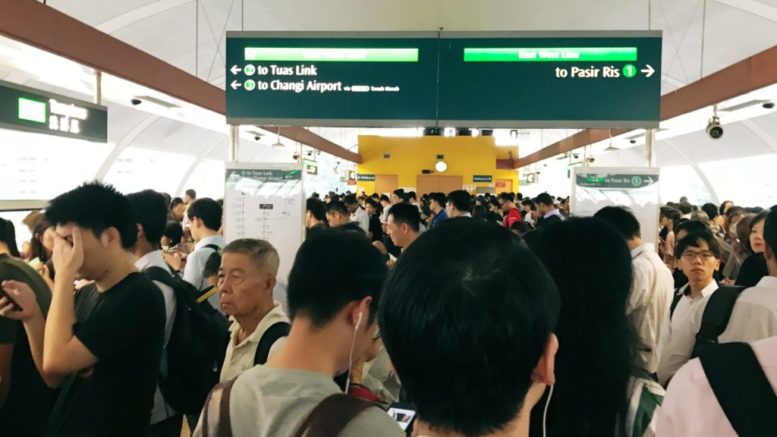Is SMRT the only company with “deep-seated cultural issues”?
SMRT CEO’s 2-page apology
I refer to the article “In full: SMRT CEO Desmond Kuek on ‘deep-seated cultural issues’ behind history of service disruptions” (Today, Oct 16).
“Gone into overdrive to address maintenance issues”
It states that “Many have asked what SMRT has done since the Dec 2011 incidents. Please allow me to address these questions upfront. Since 2012, SMRT has gone into overdrive to address maintenance issues arising from age-related serviceability issues.”
“Postponed as the maintenance team claimed it could not get a slot for track access”?
With regard to “Structurally, since 2013, we have deepened the domain expertise in each functional component – rolling stock, track permanent way, signaling, power systems – and also looked into their system integration across maintenance, engineering, projects and planning. These were deemed to be of high priority for rail reliability, and multiple projects were launched to renew or replace each of them. Within the 3-5 hours of engineering time each night, we prioritized our work so that we could meet the most pressing maintenance needs, yet allowing renewal projects to progress at best speed, and for commuter service to proceed uninterrupted the next day at dawn” – how did we end up with “They were to be inspected and maintained last month, but this was postponed as the maintenance team claimed it could not get a slot for track access during engineering hours”? (“Flooding in MRT tunnel preventable. says Khaw” (Straits Times, Oct 17).
In respect of “We beefed up and renewed the Trains team. Staff strength increased from 3,500 to 5,300 today, with nearly triple the number of Engineers to nearly 500 now. Our SMRT Institute was transformed to better meet the professional and vocational training requirements of the workforce that had been significantly expanded to meet the intensified demands. We also tied everyone’s performance incentives to a basket of measures, of which safety and reliability was given the greatest weight.”
We subjected the company to an independent review for asset management through international ISO 55001 certification and have achieved level 3 (out of a possible 4) to date. This is a serious undertaking in our concerted effort to strengthen process discipline.
We set up a Technology Management Office in 2014 to develop condition monitoring tools for critical systems, and this year started a Future Systems Office to harness digital technology and data analytics for predictive maintenance so that rail excellence can be achieved and, more importantly, sustained in an affordable way into the future.
Last year, with the more pressing reliability issues in hand, we turned our focus to address the other building infrastructure which were also aging. Many of these were under different supervisory heads. So earlier this year, we decided to place them under one division for better integration and supervision. These include platform screen doors, lifts, escalators, electrical and mechanical, fire protection and environmental control systems that have also aged and needed close attention. Their replacement also required funding support and track access priority, and we took the decision in September this year to proceed as soon as possible.
“Operation of all three pumps should not be tied to one float switch”?
Unfortunately, it was not soon enough to prevent what happened last weekend – you mean despite all the above measures, we ended up with “For one thing, the operation of all three pumps should not be tied to one float switch. Even though each of the three had its own float switch, a fourth switch detects low water levels to prevent the pumps from overheating when there is little or no water in the reservoir. This fourth switch, which overrides the rest, was the one that malfunctioned.
The system would have been more robust if the fourth “stop” switch was removed, and each individual pump had its own low-water cut-off. Many modern pumps have this in-built feature.
As Mr Khaw pointed out, two pumps would be sufficient to empty the reservoir even in heavy rain. Having three thus seems to provide sufficient redundancy. But to have all three tied to one switch undermines this redundancy”?
“Inherited, structural or cultural (issues), we make no excuses”
“Over the past five years, we have made great progress but also some mistakes. Regardless whether our issues are viewed by others as inherited, structural or cultural, we make no excuses. I take full responsibility for all that has happened under my watch as the overall Group’s chief executive.”
“Deep-seated cultural issues”
As to “There has been criticism about SMRT’s work culture. Indeed, many of our major disruptions in the past have been attributed, in some part, or all, to human error or failure. We regret that this is so.
Much progress has been made with the inculcation of a positive work culture, but there remain some deep-seated cultural issues within the company that has needed more time than anticipated to root out. It would be wrong to paint everyone in SMRT with the same brush – 9 in 10 of our people are incredibly committed, professional and commuter focused. They are Singaporeans too, with family members and friends who commute, and work hard under challenging conditions to deliver the best possible public transport service for all our commuters. We have a strong team and good people, and I deeply appreciate their steadfast support and leadership” – what exactly is the “deep-seated cultural issues within the company that has needed more time than anticipated to root out” problem – not in so many words?
Uniquely Singapore!
Leong Sze Hian
